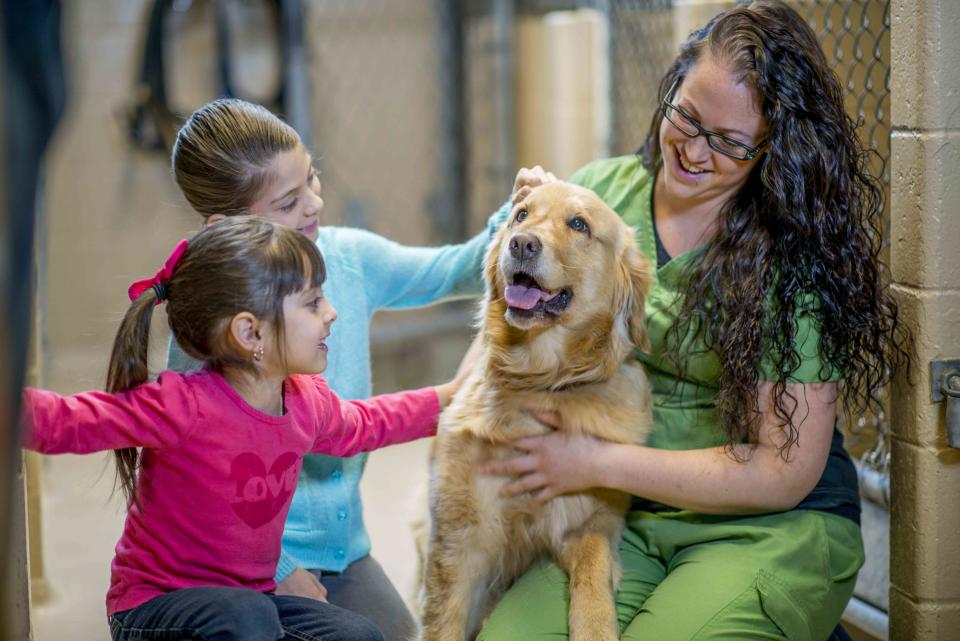6 Lifesaving Ways to Support Shelter Animals Amidst an Ongoing National Crisis
- Oops!Something went wrong.Please try again later.
Adoption isn't your only option for saving a life.

FatCamera / Getty Images
Animal shelters across the United States are struggling. According to the annual data report released by Best Friends Animal Society earlier this year, 4.4 million dogs and cats entered shelters in 2022. This is a 1.6% increase over the previous year. And even more troubling, the number of euthanized animals climbed to around 378,000, meaning more than 467 dogs and 570 cats were killed in U.S. shelters each day.
Unfortunately, the stats for 2023 are trending for the worse. “This year has been tougher,” explains Julie Castle, CEO of Best Friends Animal Society. “Animal shelters nationwide are at or over capacity and the average length of stay for shelter pets continues to rise.” Still, Castle remains confident that improvement is possible. Understanding what’s driving these numbers is the first step.
Why Are Animals Shelters in Crisis Now?
The average shelter population is comprised of strays, animals rescued from cruelty situations, and surrendered pets. Castle says there has been an increase in stray animal intakes in 2023, with 8% more entering shelters this year than in 2021. Pet surrender is on the rise as well. And while people relinquish their pets for a wide range of reasons, one that may become increasingly influential in our current economic landscape is financial hardship.
Pet owners are feeling the effects of inflation. In August of 2022, LendingTree conducted an online survey of more than 1,000 pet owners between the ages of 18 and 76 in which they asked about pet expenses. More than 75% of pet owners said inflation is making pet ownership more expensive, and 26% reported that they were having a hard time affording the rising costs. Relatedly, housing problems (a perennial top reason for pet surrender), including homelessness, displacement, and rental limitations, are likely negatively impacted by inflation, as well.
Presumably for similar reasons, adoptions aren’t keeping pace. For example, Castle notes that while around 2 million dogs entered shelters last year, dog adoptions stalled at just under 1 million.
6 Ways to Help Animal Shelters (Aside from Adoption)
Adopting a cat or dog is the quickest and most direct way to help your local animal shelter. But if that isn’t possible for you right now, there are other ways you can ease overcrowding and support the services they provide. Castle offers the following ideas:
Prevent Unwanted Litters
“It’s vital for people to spay and neuter their pets,” Castle explains. “This prevents unwanted litters and reduces the number of dogs and cats that end up in shelters.” If finances are a barrier, search for low-cost spay/neuter programs near you.
Microchip Your Pets
In the event that your pet gets separated from you and taken to an animal shelter, microchipping ensures that shelter staff will be able to contact you ASAP. This will free up much-needed space for other animals (and free your mind from worry).
Foster a Dog or Cat
“Fostering gives shelter animals a temporary place to call home and decompress while waiting for a loving home of their own,” Castle says. “Fosters are essential in helping get dogs and cats adopted because not only does it allow their personalities to blossom, which can lead to better adoption placements, but it also frees up space in a shelter for another animal in need.”
Volunteer Your Time and Skills
Animal shelters need volunteers to provide a wide variety of services, including dog walking, kennel cleaning, cat socialization, office support, landscaping, animal transportation, and fundraising/event planning. You can also pitch new ideas. For example, if you’re an experienced photographer, you could offer to take portraits of adoptable pets for a shelter’s website or social media pages.
Share Your Resources
This category isn’t limited to money (although it’s certainly helpful!). Donations of new and gently worn items like bedding, towels, toys, food bowls, and leashes are typically welcome. Food donations are also helpful, although it’s a good idea to call and ask the type of food they would prefer first. Many shelters have Amazon wishlists, making it incredibly simple to provide tangible support.
Advocate for Animals Locally and Nationally
There are many ways you can advocate for animals, shelters, and even pet owners. Consider following your local animal shelter(s) on social media. This is a great way to stay current on their needs, help reunite lost pets with their owners, and share information about adoptable pets with family and friends.
Or perhaps you’re in a position to educate area property managers on the benefits of renting to pet owners. You can also apply your efforts to broader issues, such as sending a message to your U.S. Representative regarding the PUPP Act, which would create a grant program to help homeless shelters accommodate clients with pets.
Despite last year’s dismal intake and euthanasia numbers, Best Friend’s annual report wasn’t all bad news. Since announcing their goal in 2016 of making every shelter and every community no-kill by 2025, the percentage of no-kill animal shelters in the U.S. has jumped from 24% to 57% in 2022. There’s still a long way to go in reaching this goal, but it’s a necessary reminder that change is possible.
Read the original article on The Spruce Pets.

